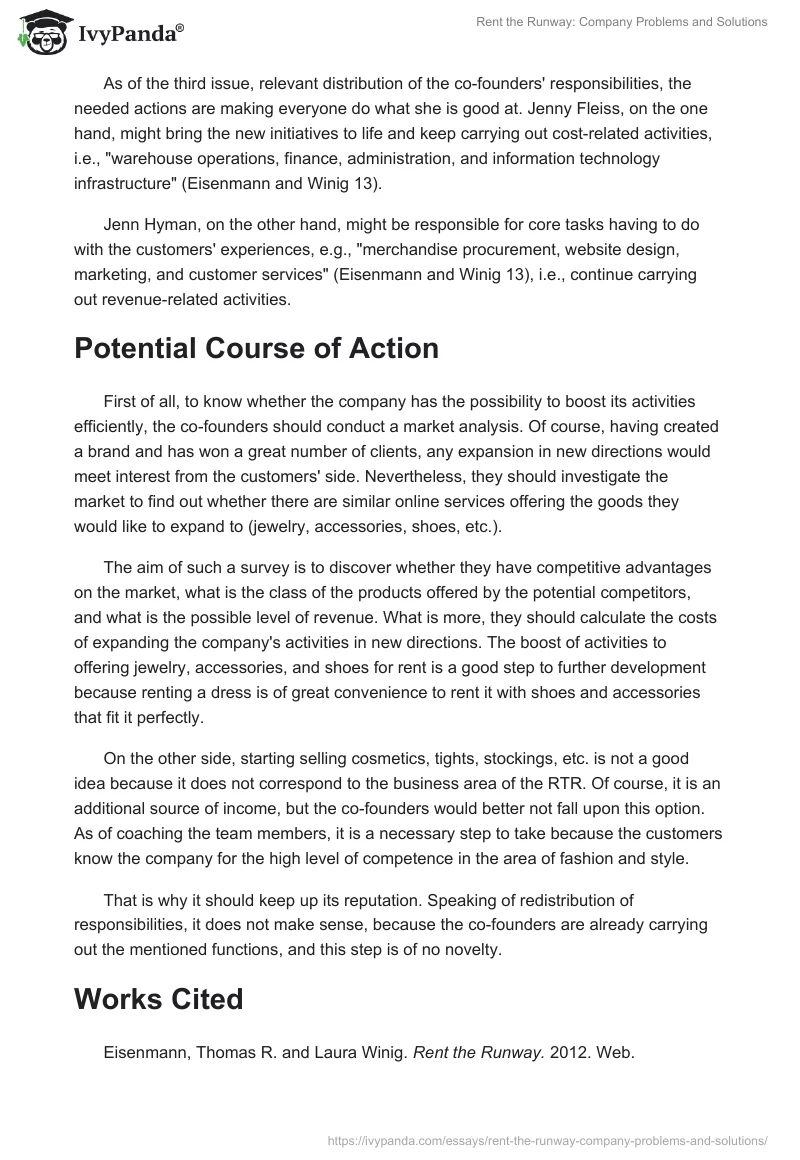“Rent the Runway” (RTR) is the online service for renting designer dresses for 10 to 15% of a designer’s retail purchase price of the dress. Jenn Hyman and Jenny Fleiss are the co-founders of the company.
Primary Problems of the Company
First of all, the problem of the company is whether there is a possibility to boost the efficiency of the company. Second, the issue is whether the team has the opportunity to follow the line of boosting efficiency while expanding its activities in new directions.
Finally, the possibility of accelerated expansion of the company raises the question of the relevant division of responsibilities of the RTR co-founders (originally, the allocation of responsibilities was as follows: Hyman was responsible for revenue-related activities while Fleiss dealt with cost-relative activities).
Potential Decisions
As of the first problem, the possibility of boosting the company’s activities, initial steps are:
Redesign [the] website to increase conversion rates from visitor to renter: analyze rental patterns and reservation data to optimize dress-buying decisions and increase inventory turns; … [hiring] a logistics expert [to] find reduce picking and packing costs and error rates. (Eisenmann and Winig, 12)
As of the second problem, whether the team has the potential to follow the increasing efficiency together with expanding in new directions, needed steps are modifying systems for order and inventory tracking as well as coach the member of the customers’ insights team on the options of expansion (Eisenmann and Winig, 13).
As of the third issue, relevant distribution of the co-founders’ responsibilities, the needed actions are making everyone do what she is good at. Jenny Fleiss, on the one hand, might bring the new initiatives to life and keep carrying out cost-related activities, i.e., “warehouse operations, finance, administration, and information technology infrastructure” (Eisenmann and Winig 13).
Jenn Hyman, on the other hand, might be responsible for core tasks having to do with the customers’ experiences, e.g., “merchandise procurement, website design, marketing, and customer services” (Eisenmann and Winig 13), i.e., continue carrying out revenue-related activities.
Potential Course of Action
First of all, to know whether the company has the possibility to boost its activities efficiently, the co-founders should conduct a market analysis. Of course, having created a brand and has won a great number of clients, any expansion in new directions would meet interest from the customers’ side. Nevertheless, they should investigate the market to find out whether there are similar online services offering the goods they would like to expand to (jewelry, accessories, shoes, etc.).
The aim of such a survey is to discover whether they have competitive advantages on the market, what is the class of the products offered by the potential competitors, and what is the possible level of revenue. What is more, they should calculate the costs of expanding the company’s activities in new directions. The boost of activities to offering jewelry, accessories, and shoes for rent is a good step to further development because renting a dress is of great convenience to rent it with shoes and accessories that fit it perfectly.
On the other side, starting selling cosmetics, tights, stockings, etc. is not a good idea because it does not correspond to the business area of the RTR. Of course, it is an additional source of income, but the co-founders would better not fall upon this option. As of coaching the team members, it is a necessary step to take because the customers know the company for the high level of competence in the area of fashion and style.
That is why it should keep up its reputation. Speaking of redistribution of responsibilities, it does not make sense, because the co-founders are already carrying out the mentioned functions, and this step is of no novelty.
Works Cited
Eisenmann, Thomas R. and Laura Winig. Rent the Runway. 2012. Web.


